We are proud to offer absolutely every tannin and additive needed for successful fermentation. Whether you need a specific additive, nutrient, or tannin addition, you'll find an extensive selection available here in a variety of sizes and bulk quantities.
Wine Fermentation Additives
-


Delvozyme® (Lysozyme)
Wine Making Use Delvozyme (Lysozyme, Lysovin) for controlling lactic acid bacteria growth in your wine. Isolated from egg whites, this enzyme will degrade the cell wall of gram positive bacteria, but will not affect yeast or gram negative bacteria such as Acetobacter. Delvozyme can be used for both Red and White Wine Malo Fermentation. Dosage: To Delay Malolactic Fermentation: Red Wine - add to grapes at 100 - 200 ppm, or 0.38 - 0.76 grams per gallon. White Wine - Add to must at 200 - 300 ppm, or 0.76 - 1.14 grams per gallon. To Block Malolactic Fermentation: White Wine - Add to must or wine at 300 - 500 ppm, or 1.14 - 1.90 grams per gallon. Stabilizing wine after MLF is complete: Add to barrel during storage at 250 - 500 ppm, or 0.95 - 1.90 grams per gallon. When blending partial and complete MLF wines: Add immeditatley after blending at 300 - 500 ppm, or 1.14 - 1.90 grams per gallon, to reduce the risk of further malolactic fermentation (MLF). Within several days any lactic should expire. For sluggish or stuck yeast fermentation: Red Wine - Add at 150 - 400 ppm, or 0.57 - 1.52 grams per gallon. White Wine - add at 300 - 500 ppm, or 1.14 - 1.90 grams per gallon. Directions for use: You can make a 10% solution of Delvozyme in water (100 grams per liter of water). However we find the easiest method is to add the desired dry weight of Lysovin in 5x its weight of warm(tepid) water. Mix for one minute, allow this mixture to stand for 45 minutes and add to must, juice or wine while mixing well. Allow 24 - 48 hours for reaction to complete. **Note: 3tsp Delvozyme = 5g Beer Making Delvozyme can be used in beer making as well. Use either in the starter (recommended if you make starters) or when pitching (adding) the yeast to the wort, do not use over 140 F. Recommended dosages is 1 tsp per 5 gallons of wort. According to studies it has no effect on flavor or clarity. Storage: Should be stored at room temperatures in a dry environment, can be stored up to 5 years.
$34.99
-


Lallzyme Cuvee Blanc | Fermentation Enzyme for White Wines
Lallzyme Cuvee Blanc – Enzyme for Aroma Release and Finesse in White and Sparkling Wines Enhances aroma expression by unlocking bound terpene and thiol precursors Improves clarification and filterability through efficient pectin breakdown Increases finesse and texture by gently releasing polysaccharides Ideal for varietal whites and sparkling base wines where delicacy is key Balanced glycosidase activity preserves freshness without compromising stability Lallzyme Cuvee Blanc is a highly specific enzyme developed by Lallemand for the production of elegant, aromatic white and sparkling wines. It offers a delicate balance of pectinase and glycosidase activity that breaks down grape cell walls to improve clarification while simultaneously releasing aroma precursors trapped in glycosidic form. This selective activity enhances varietal expression—especially in terpene- and thiol-rich varieties—without producing off-flavors or excessive bitterness. The result is a wine with lifted aromatics, better mouthfeel, and improved stability, ideal for styles requiring precision and finesse. Protocol Dilute Lallzyme Cuvee Blanc in 10 times its weight of chlorine-free water. Add to juice or wine at the preferred stage—either pre-fermentation for aroma release and settling, or post-fermentation for finishing and clarification. Ensure even distribution by mixing thoroughly. Optimal temperature range is 12–20°C. Avoid use below 10°C or in combination with bentonite or SO₂ during addition. Usage Rates Recommended dosage: 2–4 grams per hectoliter = 0.02–0.04 grams per liter = 0.076–0.151 grams per gallon Use 2 g/hL for lighter aromatics or wines already showing good varietal character. Increase to 4 g/hL in more neutral juices or when maximizing aromatic potential is desired. Allow adequate contact time—typically 24 to 48 hours—depending on the winemaking stage and style.
$2.99
-

Polycacel
This product replaces our FIN73 - Polylact Polycacel can be used both curatively and preventatively against browning and pinking in white juice or in wine under long term storage conditions. Polycacel helps improve wine color and overall organoleptic properties. A is a blend of polyvinylpolypyrolidone (PVPP), soluble postassium casein and micropulverized cellulose. This specific blend allows for more complete action on phenolic compounds while avoiding over-stripping the wine. To Use: Slowly mix Polycacel in 20 times its weight in cold water (do not use juice or wine). Allow the mixture to stand for 2 hours. For enhanced homogenization, gradually add the Polycacel to the wine container while mixing. Dosages: To protect from oxidation, add to wine and mix thoroughly: 150-300 ppm To treat oxidized juice, add during cold settling: 300-700 ppm
$5.99
-

Malic Acid
Due to high demand, the 55 lb is currently out of stock. Be the first to receive your items by placing a pre-order today. We will automatically ship this to you when we receive more inventory. 3.4g per gallon adjusts acidity by +.1%. It will lower pH less than will tartaric acid. Malic acid is the acid found in apples and is therefore the best choice for adjusting ciders. Malic is less sour than tartaric acid and can also be used to make acid adjustments in Rieslings, Gewurztraminer, and Muscat varieties, though many winemakers still prefer to use tartaric acid in these situations. You would not want to add Malic acid to any wine that will undergo a malolactic fermentation. As a note: only half of the artificially added malic acid will convert to lactic acid during a malolactic fermentation. A rough approximate of weight is 1 tsp = 2.7 grams. We highly recommend using a scale to weigh the product for an accurate dose. We do not recommend relying on these rough conversions for accurate dosage rates.
$2.99
-

Yeast Hulls | For Stuck or Sluggish Ferments
Yeast Hulls are ususally the first action when you have a stuck or sluggish alcoholic or malolactic fermentation. Yeast Hulls are essentially dead yeast cells that absorb auto toxic yeast by-products that could be inhibiting your active yeast or ML culture from doing their job - finishing your fermentation! Yeast Hulls are then typically followed by Pro-Desert in the case of a stuck alcoholic fermentation or Acti Ml in the case of a stuck ML ferment. As a side note, Yeast Hulls are included in the Fermaid K mix of nutrients to help prevent problem ferments from the onset. The reason you would not use Fermaid K for most stuck ferments is that Fermaid K contains DAP. If DAP (Diammonium Phosphate) is added to the ferment past the point of metabolization by the yeast it could potentially leave an unwanted, residual flavor. Use at the rate of .5 to .9 grams per gallon. If stored in a cool, dry place, will last up to 3 years. A rough approximate of weight is 1 tsp = 2 grams. We highly recommend using a scale to weigh the product for an accurate dose. We do not recommend relying on these rough conversions for accurate dosage rates.
$1.69
-


Scottzyme Pec5L | Pectinase | Add to Must or Juice | Increases Yield
Scottzyme PEC5L – Pectinase Enzyme for Enhanced Settling and Juice Yield Rapidly breaks down soluble pectins for faster settling and improved clarity Increases free-run and press yield by reducing viscosity and cell wall resistance Improves flotation efficiency and tightens lees compaction Effective across a wide pH range and performs well at low temperatures Ideal for white, rosé, and fruit wines requiring fast clarification and clean separation Scottzyme PEC5L is a highly active liquid pectinase enzyme formulated to reduce pectin-related haze and increase processing efficiency in juice production. By breaking down soluble pectins, PEC5L dramatically improves juice release during pressing, reduces must viscosity, and accelerates settling or flotation. The result is clearer juice, more compact lees, and higher overall yield. Its formulation is optimized for cool-temperature performance and a broad pH range, making it a versatile tool in grape and non-grape juice clarification. Unlike general pectinases, PEC5L is designed to act quickly and cleanly, without over-extraction of phenolics or bitterness. Protocol Dilute Scottzyme PEC5L in 10 times its volume of chlorine-free water or juice. Add to must or juice immediately after crushing or during transfer to settling tank. Mix well to ensure even distribution. For flotation, add just before or during the flotation process. Avoid adding at the same time as SO₂ or bentonite. Usage Rates Recommended dosage: 1.5–4.0 mL per 1000 lb of fruit or 0.075–0.2 mL per gallon of juice = approximately 0.02–0.05 mL per liter Use lower rates for clean, low-pectin fruit or warmer temperatures. Use higher rates for pectin-rich grapes, low temperatures, or difficult-to-settle musts. Allow contact time of 2 to 12 hours depending on conditions and desired level of clarification.
$13.99
-
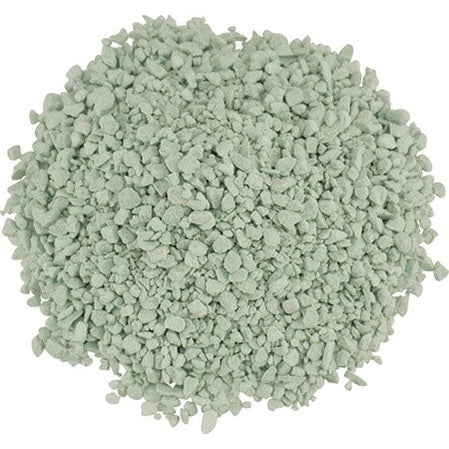
Kupzit® Hydrogen Sulfide Remover
Due to high demand, the 1 kg is currently out of stock. Be the first to receive your items by placing a pre-order today. We will automatically ship this item to you when we receive more in mid December. Kupzit® is an innovative copper citrate preparation developed for the elimination of sulfide off-flavors, particularly hydrogen sulfide odors in wine and fruit wine. Kupzit® contains 2 % copper citrate. For easy dosage and handling, it is coated onto a mineral carrier material, a particularly pure, high-quality granulated bentonite. Kupzit® reacts within minutes with sulphur compounds such as hydrogen sulfide and mercaptans. These compounds bind with Kupzit and then settle out to the bottom. Dosage and Application: Trials are absolutely recommended. Generally, the dosage amount is 5-20 g/100 L or .05-.2 g/L. Exceptionally bad cases may require up to twice as much. See the attached Manufacturer's instructions for further details along with information on dosage and storage.
$4.39
-
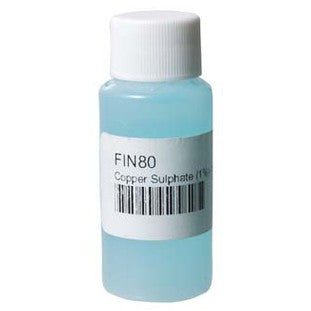
Copper Sulfate (1%) | 1 oz
Some homewinemakers will treat wine affected with Hydrogen Sulfide (rotten egg smell) by stirring with a copper rod or racking through a copper "scrubby". Copper converts the the hydrogen sulfide into copper sulfide, which is not soluble in wine. After a few days the wine is racked off the copper sulfide which by that time has precipitated down to the bottom of your vessel. However, putting wine in direct contact with a non-measured amount of copper can result in residual copper being left in your wine, especially in low pH environments. A more professional approach to the reduciton of Hydrogen Sulfide is to use a measured amount of copper sulfate in a 1% solution. Normally a trial is set up to determine the least amount needed to eliminate the problem (see FIN84 bench trial kit). Because the amounts used are very small, it will be necessary to use a pipette. Add the correct amount of copper sulphate in small .1 ppm doses. Wait several days for the copper sulfide to settle out and then rack off the lees. Do not add copper sulphate during an active fermentation as it may actually cause more hydrogen sulfide to form. If you detect hydrongen sulfide or "rotten egg" smell during fermentation, it is a sign of poor yeast nutrition. Add the recommended amount of Fermaid K (AD345) for the amount of yeast you used to correct this issue - it should keep you from having to use the copper later!
$2.29
-
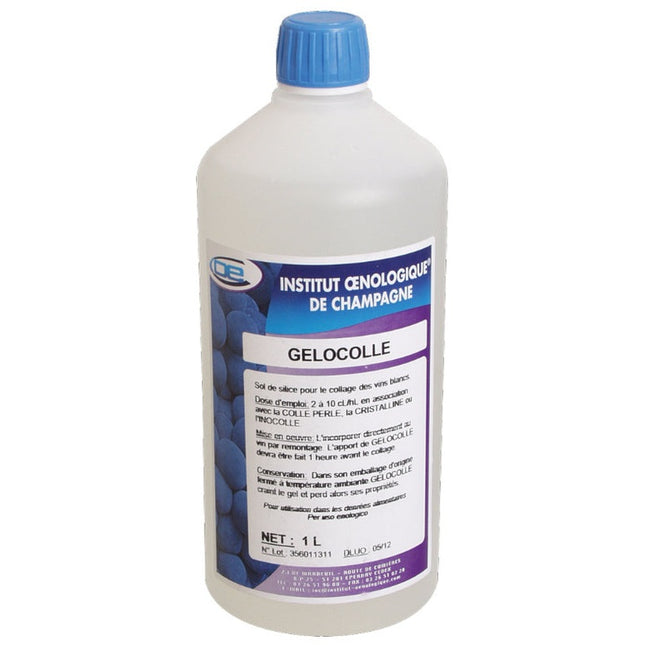
Gelocolle
Often used with isinglass, bentonite, gelatins, and other organically derived fining agents to help compact the lees, Gelocolle is a liquid solution of suspended silica that is used during fining to help improve settling. Gelocolle also helps to limit the risk of over-fining when used in conjuction with other fining agents. Gelocolle can also be used to remove excess protein in both red and white wine, thereby improving their filterability. Gelocolle is completely inert and will not add any flavor or aroma to the wine. To Use Add Gelocolle 1 hour after the fining agent. Mix well to ensure homogenization. Recommended Dosage: In general, use Gelocolle at a rate of 1 mL Gelocolle per 1 g of the fining agent you are aiding. For protein removal use 5 ml Gelocolle per gallon of wine. Note: When using Gelocolle with a gelatin fining, use 1.0 mL of Gelocolle to 1.0 mL of gelatin. Once opened use immediately. Best stored at 50-68 F (10-20 C). Gelocolle solidifies irreversibly when frozen.
$4.49
-
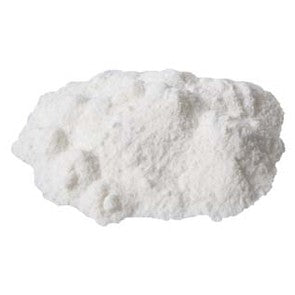
Cristalline Plus
This product is a direct replacement for our FIN74 - Ichtyocolle. Recommended for whites, roses and fruit wines, Cristaline Plus is a blend of isinglass (fish-derived protein) and citric acid stabilized with SO2. Cristaline Plus has a strong positive charge which makes it very effective at improving the clarity of a wine (even those that are made from botrytised grapes). As an added benefit, Cristaline Plus can help improve the filterability of a wine. Cristaline Plus is not sensitive to cold temperatures and may be slow to finish settling. The use of Gelocolle (FIN64) an hour after the addition of Cristaline Plus will help speed the settling process and create a more compact lees. To Use: Dissolve Cristaline Plus in 150-200 times its weight (75-100 mL) of clean, warm water (59-68 F/15-20 C) Let mixture swell for 3 hours If the solution is too viscous add additional warm water Add the solution quickly into the whole volume of wine to be treated while stirring and mix well to distribute the Cristaline Plus evenly throughout the wine Rack as soon as the lees are well settled (wait 72 hours before filtering or allow 8-10 days settling before racking) Dosage Range: 15-30ppm (mg/L)
$1.79
-


Lallemand | Go-Ferm Sterol Flash™ | Reydrate Yeast in Cold Water
Due to high demand, the 10 kg is currently out of stock. Be the first to receive your items by placing a pre-order today. We will automatically ship this to you when we receive more inventory. Improves fermentation kinetics and aroma production Allows yeast to be rehydrated in cool water (60°F) without any loss of viability or vitality Eliminates the need for acclimatization steps—rehydrated yeast can be added directly to juice or must after 15 minutes Requires 50% less water than Go-Ferm™ or Go-Ferm Protect Evolution™ Non-clumping, instantly disperses in cool water Go-Ferm Sterol Flash™ is a revolutionary new yeast rehydration nutrient that is fast, simple to use, and saves time, labor, and water without compromising on yeast viability and vitality. Derived from autolyzed yeast, Go-Ferm Sterol Flash™ provides optimized levels of micronutrients (vitamins and minerals) and extremely high levels of survival factors including sterols and unsaturated fatty acids. Go-Ferm Sterol Flash™ has the highest bioavailability of sterols and is produced with a specific Lallemand micro agglomerated process, for instant dispersion during the rehydration step. When suspended in cool water, the high content of sterols are quickly released and integrated in the yeast membrane within 15 minutes. The high content of sterols reinforces the permeability and fluidity of the yeast membrane. Go-Ferm Sterol Flash™ increases yeast viability, yeast vitality, and optimizes wine yeast aroma precursors assimilation under any conditions in red, rose, and white wine fermentation. With Go-Ferm Sterol Flash™, no yeast acclimatization steps are required before inoculation in must. Go-Ferm Sterol Flash™ is a revolutionary yeast rehydration protector with instant dispersion in cool water for a more reliable alcoholic fermentation and wine yeast sensory impact. Use: Use at a rate of 1.25 g Go-Ferm Protect per 1 g of yeast. A rough approximate of weight is 1 tsp = 3.2 grams. We highly recommend using a scale to weigh the product for an accurate dose. We do not recommend relying on these rough conversions for accurate dosage rates. Click Here for a copy of MoreWine!'s Guide to Yeast Rehydration Store in a cool and dry environment at 65°F. Once opened, keep tightly sealed and dry.
$3.49
-
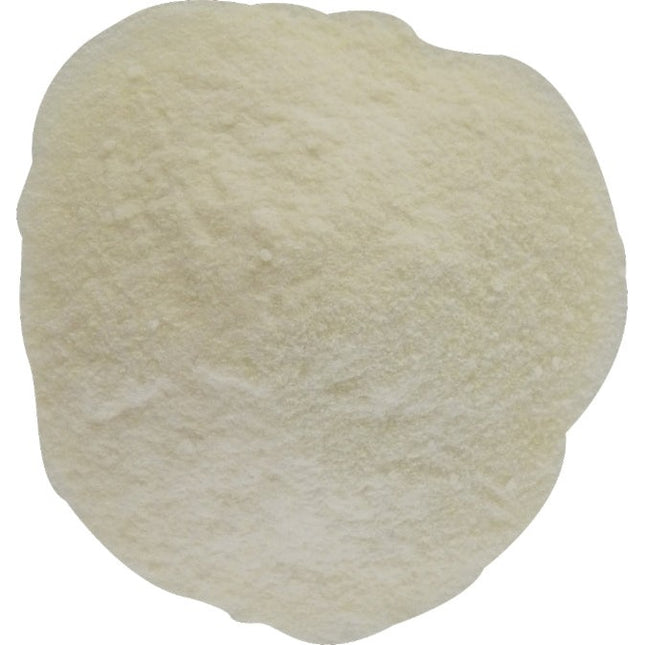
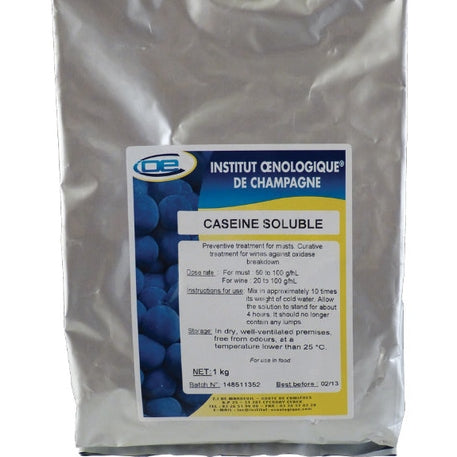
Caseinate de Potassium (Caseine Soluble)
Caseinate de Potassium, formally Caseine Soluble, is a concentrated, powdered form of Potassium Caseinate produced from milk. Helps eliminate oxidized phenolic (brown colored) and bitter compounds in white wines, rose wines, fruit wines, and meads. Caseinate de Potassium can be used preemptively in the must or as a curative step on finished wine. Recommended Dosage: In Juice: 1.9-3.8 g/gal (500-1000 ppm) In Wine: 0.8-3.8 g/gal (200-1000 ppm) Preparation For Use Add the pre-measured amount of Caseinate de Potassium to 10 times its weight of cold water (do not use juice or wine). Allow the solution to swell for 4 hours Stir to dissolve any lumps When completely dissolved, add the mixture slowly to the juice or wine while stirring continuously (for juice, add Caseinate de Potassium before settling). Once added, strongly stir the entire wine volume to get the Caseinate de Potassium to integrate with the wine. Once Caseinate de Potassium has been dissolved, use the preparation within 2 hours. Minimum contact is 2 days, maximum 15 days. The amount needed for your specific wine is best determined by a bench trial. A rough approximate of weight is 1 tsp = 2.3 grams. We highly recommend using a scale to weigh the product for an accurate dose. We do not recommend relying on these rough conversions for accurate dosage rates.
$7.99
-


Ascorbic Acid
Ascorbic acid is a quick-acting and powerful antioxidant that is used in white winemaking to protect against light and short aerations, such as racking and bottling. It works by rapidly converting dissolved oxygen into hydrogen peroxide before it has a chance to react with oxidative enzymes and cause browning. However, this hydrogen peroxide itself needs to be removed from the wine in order to avoid the very phenomenon that was trying to be avoided in the first place, namely oxidizing the wine. The answer lies in always making sure that the free SO2 levels are correct, both before the ascorbic addition is to be made and after. (Note that "Titrettes" are not accurate enough for this, and that a more precise means of determing free SO2 is needed, such as an Aeration-Oxidation set-up). Addition rate is around 50 mg/l (ppm) as long as the free SO2 is maintained at 30 mg/l (ppm). A rough approximate of weight is 1 tsp = 3.2 grams. We highly recommend using a scale to weigh the product for an accurate dose. We do not recommend relying on these rough conversions for accurate dosage rates.
$2.49
-
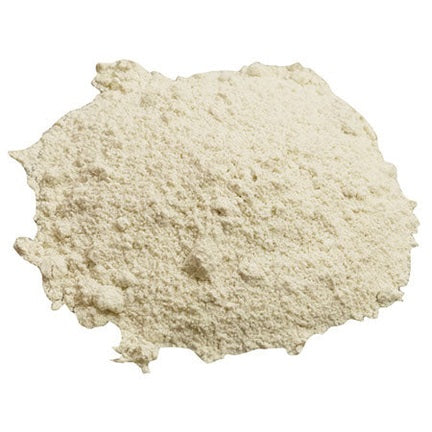
Bentolact S
Bentolact S is a proprietary IOC blend of soluble casein and bentonite. It is most effective when used early (during cold settling). This fining agent is formulated for the preventative treatment of must prone to oxidation. It will help prevent the formation of undesirable off-characters. Using this with whites, roses, and light fruit wines will help prevent any negative characters from forming as a result of oxidation during processing. Juice - Applied at a rate of 2.25 g / gal. Wine - Applied at a rate of 6 g / gal. Dissolve in 10 times its weight in cold water and mix vigorously to dissolve any clumps. Allow the mixture to stand for 3 hours. Add to the juice or wine during a pump-over or a good mixing. Depending upon the wine, a Bentolact S addition may take up to 7 days to settle. Please Note: For best results, Bentolact S should be mixed in the juice or wine during a pump-over or tank mixing.
$5.99
-

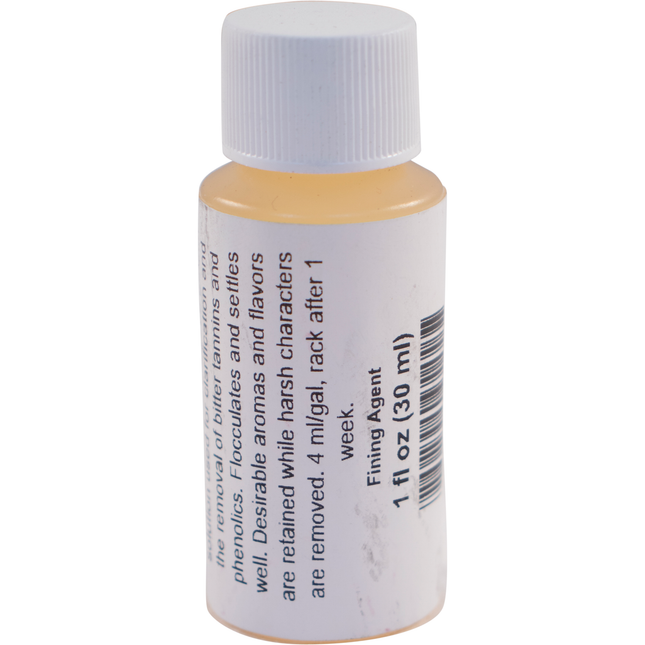
Colle Perle
Colle Perle is a hydrolyzed gelatin solution. Primary uses are clarification and the removal of bitter tannins and phenolics. Colle Perle flocculates and settles well. Desirable aromas and flavors are retained while harsh characters are removed. It is particularly useful to optimize potential of hard pressed product. In white wines it can be used in conjunction with bentonite to compact lees. Dosage - Applied at a rate of 4 ml / gal. Usage: Juice - Dilute Colle Perle 1:1 in water. Add at the beginning of cold settling and mix evenly and completely throughout the juice. When used in juice Colle Perle should be used in conjunction with bentonite or Gelocolle to improve settling. Racking should be done after 1 week. Wine in Aging - Dilute Colle Perle 1:1 in water. Stir vigorously into the wine to ensure thorough distribution. Racking should be done after 1 week. Filtration is possible 48-72 hours after fining with Colle Perle.
$5.99
-


Scottzyme HC
Scottzyme HC is a blend of assorted enzymes designed to increase yield in apple, pear, stone fruits, and wetter grapes (such as concords). This enzyme will assist in breaking down the fruit you work with to help extract more flavor and juice, as well as improving filterability and overall clarity. This Scottzyme works best in conjunction with PEC5L.
$13.99
-


Scottzyme KS | For Difficult Wines When Pec5L is Not Enough
cottzyme KS – High-Power Enzyme for Complex Pectin Breakdown in Red, White, and Problem Wines Breaks down complex, highly esterified pectins that standard pectinases cannot Enhances clarification, settling, and filterability in challenging juices and wines Boosts juice and wine yield by improving extraction from thick-skinned or high-pectin fruit Ideal for problem fermentations or hazy wines that resist fining and filtration Performs well at low temperatures and in a broad pH range Scottzyme KS is a specialized pectolytic enzyme designed to break down complex pectin structures found in high-pectin varietals and difficult ferments. While standard enzymes like PEC5L target simple soluble pectins, KS is formulated with enhanced side-chain cleaving activity that attacks esterified pectins and heavily branched structures. This makes it particularly effective on cultivars like Pinot Gris, Riesling, Gewürztraminer, Muscat, and in juice or wine where haze persists despite prior enzymatic treatment. KS improves clarification, tightens lees, increases press and wine yields, and boosts filtration efficiency—especially in wines that defy typical settling protocols. Comparison to Scottzyme PEC5L: Scottzyme PEC5L is a fast-acting general-purpose pectinase for typical clarification tasks, such as settling and flotation of white and rosé juices. It’s ideal for clean juice production from standard grapes and most fruit wines. In contrast, KS is the go-to choice when PEC5L isn’t enough—it’s stronger on stubborn, esterified pectins and delivers better results with problematic varieties or ferments that remain hazy even after PEC5L. While PEC5L is excellent for fast juice prep, KS excels in the most difficult cases, including post-fermentation haze and challenging press fractions. Protocol Dilute Scottzyme KS in 10 times its volume of chlorine-free water or juice. Add to must, juice, or wine and mix well. Suitable for use before or after fermentation. Do not add simultaneously with bentonite or high SO₂. Works effectively at 10–20°C. Usage Rates Recommended dosage: 1.5–4.0 mL per 1000 lb of fruit or 0.075–0.2 mL per gallon = approximately 0.02–0.05 mL per liter Use lower rates for moderate haze and extended contact time. Use higher rates in cold settling, high-pectin juices, or persistent post-fermentation hazes. Allow 4–24 hours of contact time depending on application.
$14.99
-


Nutrient Vit End | Fermentation Nutrient for End of Fermentation
Vit End – Lallemand Yeast Nutrient for Securing Fermentation Completion Supports yeast vitality during the final stages of alcoholic fermentation Provides essential vitamins, minerals, and survival factors to avoid sluggish finishes Reduces the risk of stuck fermentation by reactivating stressed or nutrient-starved yeast Enhances sugar-to-ethanol conversion efficiency for cleaner fermentation ends More targeted than general nutrients due to its late-fermentation formulation Vit End is a specialized nutrient developed by Lallemand for use at the end of alcoholic fermentation, when yeast cells are most vulnerable to nutrient depletion, ethanol toxicity, and osmotic stress. Unlike standard yeast nutrients formulated for the growth phase, Vit End is designed to support cell survival, membrane integrity, and residual sugar metabolism. It contains inactivated yeast rich in survival factors, specific vitamins, minerals, and sterols that help re-energize exhausted yeast populations, allowing them to finish fermentation smoothly. Wines showing signs of slowing kinetics, high residual sugar, or difficult fermentation conditions benefit from the targeted support Vit End provides. Protocol Suspend Vit End in ten times its weight of clean must or wine at 20–25°C. Stir thoroughly to dissolve. Add when fermentation is slowing (often near 0–5°Brix) or when signs of yeast stress appear. Mix well to ensure even distribution. Do not add simultaneously with bentonite or sulfites. Usage Rates Recommended dosage: 20–40 grams per hectoliter = 0.2–0.4 grams per liter = 0.76–1.5 grams per gallon Use 20 g/hL in moderate stress conditions. Increase to 40 g/hL in fermentations that are near-stuck, have high residual sugar, or show signs of yeast stress. Vit End can also be used proactively in fermentations known to be high-risk due to low YAN, high sugar, or challenging varietals.
$3.29
-

Sorbistat K (Potassium Sorbate)
Sorbistat K, Potassium Sorbate, ensures against renewed fermentation in wine when residual sugar is added post the initial ferment. Add at the rate of .5 to .75 grams per gallon (125-200ppm) in conjunction with .3 grams of meta-bisulphite (50ppm) per gallon. Use the higher end of the range (200 ppm) as the wine's pH approaches or exceeds 3.5 or when the alcohol conent of the wine is below 10%. Note: Will not stop an active fermentation. Potassium sorbate should not be used if the wine underwent an ML fermentation because sorbic acid (in the potassium sorbate) will react with lactic bacteria to produce a "geranium" smelling off-flavor. A rough approximate of weight is 1 tsp = 2.3 grams. We highly recommend using a scale to weigh the product for an accurate dose. We do not recommend relying on these rough conversions for accurate dosage rates.
$3.49
-

Lallemand OPTI'MALO BLANC™ | ML Nutrient for White and Rose Wines
Opti’Malo Blanc – Malolactic Nutrient for White and Rosé Wines Supports reliable malolactic fermentation in nutrient-deficient white and rosé wines Provides amino acids, peptides, polysaccharides, and minerals essential for bacterial activity Shortens MLF duration, allowing faster wine stabilization and reduced microbial risk Particularly beneficial in Chardonnay, where peptide levels are naturally low OMRI listed and ideal for use in organic winemaking Opti’Malo Blanc is a targeted malolactic fermentation nutrient designed specifically for white and rosé wines. These wines often lack the peptides and cofactors needed by Oenococcus oeni, making MLF more challenging and prone to delays or failure. Opti’Malo Blanc delivers a balanced supply of amino acids, desirable peptides, polysaccharides, and minerals derived from specific inactivated yeast. These nutrients promote bacterial health, enhance malic acid metabolism, and reduce the duration of malolactic fermentation. This is especially useful in varietals like Chardonnay, where peptide deficiencies can limit bacterial performance. The result is a healthier MLF with improved reliability and shorter fermentation time, making it easier to stabilize wines earlier in the winemaking process. Protocol Suspend Opti’Malo Blanc in a small volume of clean water or wine. Add directly to the wine immediately before inoculating with malolactic bacteria. Do not add to the malolactic rehydration water. Mix thoroughly to ensure even distribution. Usage Rates Recommended dosage: 20 grams per hectoliter = 0.2 grams per liter = 0.76 grams per gallon Use at the time of malolactic inoculation for best results. Especially effective in low-peptide wines or where MLF success has historically been difficult. Ask ChatGPT
$69.99
-

AEB Catalasi | Anti-Oxidizing Clarifier | 20 kg
Prevents undesirable color changes in white, rosé, and red wines Reduces high phenolic content to diminish color in varietals like Pinot Grigio Enhances and cleans up original aromas while reducing oxidized components Contains Ascorbic Acid and SO2 for optimized antioxidant and microbial control Thanks to its high content in K-Caseinate, Catalasi can be used to successfully eliminate or prevent darkening of white wines, the occurrence of “brick” hues in rosé, and yellow hues in red wines. Also, it will substantially diminish the color in Pinot Grigio and other white varietals characterized by high phenolics. Catalasi will highlight the original aromas and color, reducing the level of polyphenols and polymerized, oxidized components. Added to fermentation it will promote the development of a ore clean and complex bouquet. It contains 4% Ascorbic, a strong antioxidant that can quickly reduce oxygen. This reaction is known to produce a strong oxidant, H2O2, and because of that, winemakers are afraid to use it. However, the oxidative species produced by the reaction between oxygen and ascorbic acid will react quickly with SO2. For this reason, the SO2 present in Catalasi, other than controlling the microbial environment, will optimize the efficiency of this product as an antioxidant. Composition Activated bentonite, potassium caseinate, potassium metabisulfite, swine soluble gelatin, ascorbic acid. Dosage From 15 to 100 g/hL. For every 10 g/hL of Catalasi addition, there is an increase of 6,24 mg/L of SO2 in the wine. Use Dissolve the dose of Catalasi in about 5 parts of cold water, wait 15 minutes and mix. Wait at least 20 minutes before use and add quickly to mass with maximum turbulence.
$424.99
-

AEB Fermotan Liquid | Fermenation Tannin | 25 kg
Designed for use during fermentation to stabilize color and improve phenolic integration Mixes much easier than powdered tannins thanks to its liquid formulation Composed of ellagic tannins (oak) and condensed tannins (exotic woods) Protects wine from oxidation by acting as a sacrificial tannin and antioxidant Promotes anthocyanin-tannin binding, improving long-term color and mouthfeel stability Ideal for red wines needing structure, color retention, and oxidative protection from the start Fermotan Liquid is a balanced blend of ellagic, proanthocyanidinic, and gallic tannins designed to strengthen color, stabilize phenolic compounds, and shape the sensory profile of wines. Its liquid formulation makes it easy to dose and ensures rapid integration without the need for prior solubilization. Used during red wine fermentation, Fermotan Liquid enhances structure, preserves varietal character, and supports long-term aging potential. The result is a wine with deeper color, lifted aromatics, and a rounder, more polished mouthfeel compared to tannins from other sources. From the onset of fermentation, anthocyanins are extracted faster than tannins. In order not to extract these color compounds in vain, it is imperative to protect them from the oxygen and steer them towards stable polymerization forms, such as those with proanthocyanidins. The synergy among the three classes of tannins (ellagic, proanthocyanidinic and gallic), exerts a triple protective action towards the anthocyanins. Protocol Add directly to the must at the beginning of alcoholic fermentation, ensuring thorough homogenization. Usage Rates 0.05–0.20 ml/L (0.19–0.76 ml/gal)
$449.99
-

AEB Fermocel P Fermentation Aid | Inactivated Yeast & Cellulose | Improves Fermentation | 25 kg
Supports healthy yeast metabolism during alcoholic fermentation Provides detoxifying action through inert cellulose, absorbing fermentation inhibitors Improves fermentation kinetics and reduces the risk of sluggish or stuck fermentations Enhances yeast distribution in the must, promoting uniform activity Boosts wine stability and aromatic freshness by reducing reductive off-notes Fermocel is an inactivated yeast-based fermentation aid enriched with purified cellulose, designed to improve the performance and reliability of alcoholic fermentation in white, rosé, and red wines. The cellulose acts as a physical support and detoxifying agent, adsorbing inhibitory compounds such as medium-chain fatty acids and pesticide residues that can hinder yeast performance. By promoting more uniform yeast dispersion and reducing stress factors, Fermocel helps prevent sluggish or stuck fermentations, especially in musts with high sugar content or low nitrogen availability. Its use results in cleaner, fresher wines with more complete fermentation and better preservation of aroma and mouthfeel. Protocol Rehydrate Fermocel in 10 parts chlorine-free water or must at room temperature Mix thoroughly to form a uniform suspension Add directly to the must at the start of alcoholic fermentation or during active fermentation if signs of stress occur Ensure proper mixing for even distribution Usage Rates Application Dosage (g/L) Dosage (g/gal) Preventive use 0.25–0.50 0.95–1.89 Corrective use (high-stress musts) 0.50–1.00 1.89–3.79
$239.99
-

AEB Deacid | Reduces Total Acidity | AEB | 25 kg
Reduces total acidity in musts and wines with precision and stability Blended formulation of potassium bicarbonate and potassium tartrate minimizes pH overshoot Preserves sensory quality while softening harsh acidity Safer and more predictable than using raw deacidification salts individually Improves conditions for malolactic fermentation by moderating acid stress Deacid is a ready-to-use deacidification agent developed to safely and effectively lower acidity in musts and wines. It combines the acid-neutralizing power of potassium bicarbonate with the buffering and stabilizing action of potassium tartrate. This dual-action formula reduces the sharpness of excessive tartaric acid while avoiding the risks of using raw bicarbonate alone, such as overcorrection, CO₂ volatility, or sensory imbalance. Deacid works gently and predictably, preserving freshness and avoiding chalky or soapy off-notes. It also promotes a more favorable environment for malolactic fermentation to proceed by reducing overall acid stress. Winemakers choose Deacid not only for its effectiveness, but for its convenience, safety, and wine-friendly balance compared to standalone chemical treatments. Protocol Gradually add the calculated dose directly into the must or wine, ideally during pumping-over to ensure even distribution. If preferred, pre-dissolve in warm, chlorine-free water before addition. Monitor CO₂ release and volume increase during application. Rack or filter after salt precipitation settles fully. Usage Rates The manufacturer specifies 130 g/hL per 1 g/L reduction in total acidity. We’ve converted to more easily used dosage rates. Target Acidity Reduction Dosage (g/L) Dosage (g/gal) 1 g/L TA reduction 1.30 4.92 2 g/L TA reduction 2.60 9.84 3 g/L TA reduction 3.90 14.76 Conduct bench trials to verify target acidity correction and flavor outcome prior to bulk application.
$339.99


































